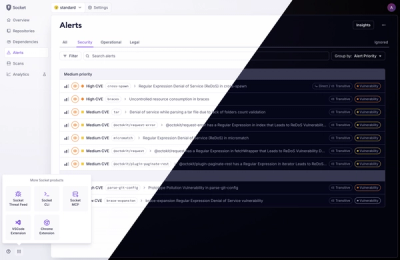
Product
A Fresh Look for the Socket Dashboard
We’ve redesigned the Socket dashboard with simpler navigation, less visual clutter, and a cleaner UI that highlights what really matters.
@webiny/api-security
Advanced tools
A collection of plugins that sets up the Webiny Security Framework in @webiny/handler handlers.
npm install --save @webiny/api-security
Or if you prefer yarn:
yarn add @webiny/api-security
The first step is to add the security plugins in your handler, for example:
import { createHandler } from "@webiny/handler-aws";
import graphqlPlugins from "@webiny/handler-graphql";
import logsPlugins from "@webiny/handler-logs";
import securityPlugins from "@webiny/api-security";
const debug = process.env.DEBUG === "true";
export const handler = createHandler({
plugins: [
// Webiny Security Framework plugins are registered here.
securityPlugins(),
logsPlugins(),
graphqlPlugins({ debug })
],
debug
});
Next, for type-safety and easier discovery down the road, it's recommended you update the main Context interface that describes the handler's context object. In Webiny projects, the interface can be found in types.ts file, for example apps/api/graphql/src/types.ts or apps/api/headlessCMS/src/types.ts.
import { Context as BaseContext } from "@webiny/handler/types";
import { ClientContext } from "@webiny/handler-client/types";
// Import the `SecurityContext` from `@webiny/api-security/types`.
import { SecurityContext } from "@webiny/api-security/types";
export interface Context
extends BaseContext,
// Simply add the interface like to the list.
SecurityContext {}
Finally, the security doesn't do much on its own. So, the final step would be to also add the appropriate package that implements the necessary internal processes for your identity provider, for example @webiny/api-security-cognito-authentication:
import { createHandler } from "@webiny/handler-aws";
import graphqlPlugins from "@webiny/handler-graphql";
import logsPlugins from "@webiny/handler-logs";
import securityPlugins, { SecurityIdentity } from "@webiny/api-security";
import cognitoAuthenticationPlugins from "@webiny/api-security-cognito-authentication";
const debug = process.env.DEBUG === "true";
export const handler = createHandler({
plugins: [
// Webiny Security Framework plugins are registered here.
securityPlugins(),
// Add Amazon Cognito authentication plugins.
cognitoAuthenticationPlugins({
region: process.env.COGNITO_REGION,
userPoolId: process.env.COGNITO_USER_POOL_ID,
identityType: "user",
}),
logsPlugins(),
graphqlPlugins({ debug })
],
debug
});
For more information on the Amazon Cognito plugins and all of the available configuration parameters, check the @webiny/api-security-cognito-authentication package.
FAQs
Security layer for the Webiny GraphQL API.
The npm package @webiny/api-security receives a total of 439 weekly downloads. As such, @webiny/api-security popularity was classified as not popular.
We found that @webiny/api-security demonstrated a healthy version release cadence and project activity because the last version was released less than a year ago. It has 1 open source maintainer collaborating on the project.
Did you know?

Socket for GitHub automatically highlights issues in each pull request and monitors the health of all your open source dependencies. Discover the contents of your packages and block harmful activity before you install or update your dependencies.

Product
We’ve redesigned the Socket dashboard with simpler navigation, less visual clutter, and a cleaner UI that highlights what really matters.

Industry Insights
Terry O’Daniel, Head of Security at Amplitude, shares insights on building high-impact security teams, aligning with engineering, and why AI gives defenders a fighting chance.

Security News
MCP spec updated with structured tool output, stronger OAuth 2.1 security, resource indicators, and protocol cleanups for safer, more reliable AI workflows.